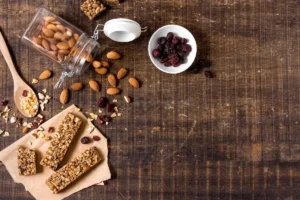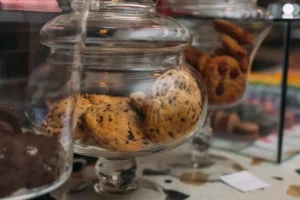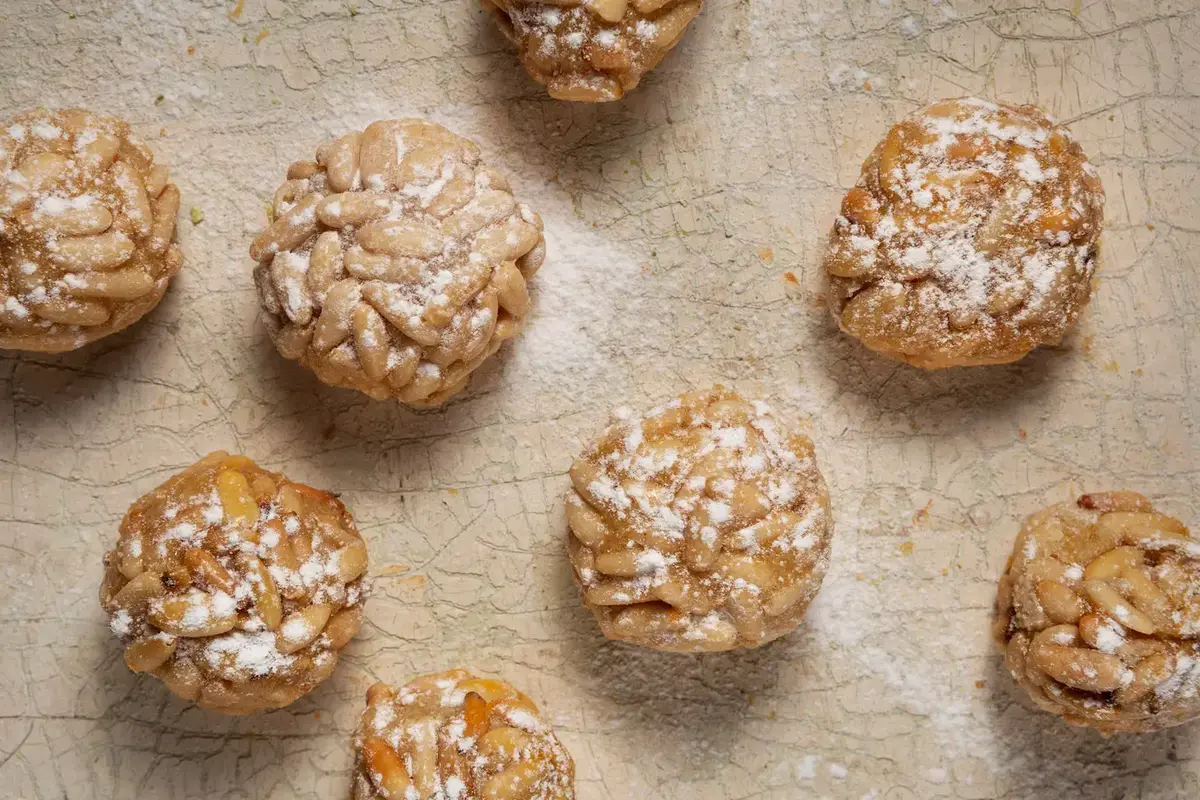Introduction to Pignoli Cookies
Ah, Pignoli cookies—a name echoing with Italian baking tradition. These treats are not just sweets; they’re an adventure into rich culinary heritage, famed for their nutty taste and chewy texture. Let’s explore the history of these exquisite cookies.
Originating from Italy’s sunny regions, Pignoli cookies are a pillar of Italian patisserie, symbolizing both festive and everyday joys. Known for their simplicity and grace, they embody Italian baking’s core principle: letting quality ingredients shine.
Central to Pignoli cookies is a blend of choice ingredients: almond paste, offering rich sweetness; egg whites, for a light texture; and the star—pine nuts. These seeds add a subtle crunch and flavor, making the cookie sophisticated and tasty.
What distinguishes Pignoli cookies is their reflection of Italian culinary philosophy: a focus on regional ingredients, natural flavors, and craftsmanship. This commitment to authenticity has made Pignoli celebrated worldwide, from Italian weddings to dessert menus globally.
Our exploration will unveil preparation secrets, guide on selecting top ingredients, and introduce variations. Whether you’re a baking veteran or new to Italian cookies, this dive into Pignoli’s essence promises a journey as enriching as it is sweet. So, let’s start this exploration of the nutty, chewy delights that have won over food enthusiasts everywhere.
The Key Ingredients of Pignoli Cookies

Diving into the heart of Pignoli cookies, it becomes clear that their charm lies in the simplicity and quality of their ingredients. Each component plays a pivotal role, coming together to create a cookie that’s both rich in flavor and texture. Let’s unravel the essentials that make these cookies a standout treat.
Almond Paste
At the core of every Pignoli cookie is almond paste, a rich blend of ground almonds and sugar, which infuses the cookies with a deep, nutty flavor and moist texture. Opting for high-quality almond paste can make all the difference, giving the cookies their characteristic richness. For those feeling adventurous, making your own almond paste at home is a rewarding endeavor, offering a fresh and personalized touch to your cookies.
Sugars
The sweet symphony in Pignoli cookies is played by two types of sugar: white and confectioners’. White sugar blends with the almond paste to create a smooth base, while confectioners’ sugar adds a delicate sweetness and contributes to the cookies’ tender crumb. The balance between these sugars ensures a cookie that’s just sweet enough, highlighting the natural flavors of the other ingredients.
Egg Whites
Egg whites are the secret to the light, airy texture of Pignoli cookies. They act as a binding agent, holding the cookies together without adding any fat. The result is a delightfully chewy center that contrasts beautifully with the crispiness of the toasted pine nuts. It’s a testament to the magic of simple ingredients, transforming the dough into airy bites of bliss.
Pine Nuts
Pine nuts, or pignoli, are the stars of the show, lending their name and distinctive flavor to the cookies. These buttery, nutty seeds are pressed into the dough before baking, creating a toasty, crunchy exterior that complements the soft interior perfectly. For those seeking a more budget-friendly option, sliced almonds can serve as a substitute, offering a similar texture and taste profile.
Flour
While not a main ingredient, flour plays a crucial role in the baking process. A light dusting on your hands can prevent the sticky dough from adhering to your skin, making it easier to form the cookies. This small but mighty ingredient ensures a smooth baking experience, allowing the dough to take shape without losing its delicate texture.
Together, these ingredients weave a tale of tradition and taste, each adding its own note to the symphony of flavors that is a Pignoli cookie. It’s a testament to the power of simplicity, proving that a few well-chosen components can create a masterpiece of Italian baking. As we venture further into the art of making these exquisite cookies, remember, the quality of ingredients can elevate your baking from good to unforgettable.
How to Make Pignoli Cookies

Embarking on the baking journey of Pignoli cookies, we find ourselves at the heart of Italian tradition, where the magic of simple ingredients transforms into an exquisite confection. This part of our adventure is not just about following a recipe; it’s about embracing the art of Italian baking, where every step is a dance of flavors and textures. So, let’s get our baking sheets ready and dive into the delightful process of making these nutty, chewy treasures.
Preparing the Almond Paste and Sugar Mixture
The first step in our culinary ballet begins with the almond paste. This key ingredient needs to blend smoothly with the white sugar to form the base of our cookies. Imagine the almond paste as the foundation of a magnificent Italian villa, where everything that follows adds to its beauty. Using a food processor, blend until you get a fine, sandy texture, ensuring the sweetness permeates every grain of almond. This mixture sets the stage for a cookie that’s rich, nutty, and irresistibly sweet.
Incorporating Egg Whites
Next, we introduce egg whites to our almond-sugar mixture, a step akin to opening the windows of our villa to let in the light. The egg whites bring airiness to the dough, giving our cookies their signature chewy texture. It’s crucial to blend them just right—not too much, lest we lose the air; not too little, or our cookies won’t hold together. This balance is the secret to achieving the perfect texture, a dance of ingredients that’s both delicate and precise.
Forming and Baking the Cookies
Now comes the moment of transformation, where our dough begins to take shape. With hands lightly dusted with flour, we roll the dough into balls, an act as tender as planting seeds in a garden. Each ball is then coated in egg whites and rolled in pine nuts, dressing them in a crunchy exterior that contrasts beautifully with the soft interior.
As we lay our cookie balls onto the baking sheet, we’re not just preparing to bake; we’re setting the stage for a culinary masterpiece. Baking until lightly browned, we watch as our efforts blossom into golden, nutty Pignoli cookies, each one a testament to the beauty of Italian baking.
Tips for Perfect Cookies
As we near the end of our baking journey, let’s pause to gather some wisdom from Italian kitchens. First, the quality of your almond paste can make or break your cookies; opt for the freshest you can find. Second, don’t skimp on the pine nuts—though they may be pricey, their flavor is irreplaceable. And finally, patience is key; allow your cookies to cool completely before indulging, as this is when their texture perfects itself.
In the dance of baking Pignoli cookies, every step, every ingredient, plays a crucial role. From the rich foundation of almond paste and sugar to the airy lift of egg whites, culminating in the nutty embrace of pine nuts, this journey is one of tradition, flavor, and the joy of Italian baking. So, as you take that first bite, remember: you’re not just tasting a cookie; you’re savoring a piece of Italy’s culinary heritage.
Storing Pignoli Cookies

After the oven’s warmth fades and the last batch of Pignoli cookies cools on the rack, we’re faced with a delightful dilemma: how to preserve these tender, nutty treasures. Proper storage is not just about prolonging the life of our cookies; it’s about maintaining their exquisite texture and flavor, ensuring that each bite remains as enchanting as the first. So, let’s explore the best practices for keeping our Pignoli cookies in perfect condition.
Best Practices for Storage
The key to storing Pignoli cookies lies in finding the perfect environment—neither too dry nor too humid. An airtight container is your best friend here, acting like a treasure chest that locks in freshness and keeps unwanted moisture at bay. Place your cookies in a single layer, each one a precious gem to be savored.
If you find yourself with more cookies than your container can accommodate in a single layer, don’t fret! Wax paper becomes your ally, allowing you to stack the cookies without fear of them sticking together. This simple layering technique ensures that every cookie remains intact, preserving the delicate balance of chewy and crunchy that makes them so irresistible.
How to Extend Their Freshness
For those looking to keep their Pignoli cookies fresh for as long as possible, a few extra steps can make all the difference. First, consider the room temperature. A cool, dry place away from direct sunlight helps prevent the cookies from becoming too hard or too soft. Think of it as creating a little sanctuary for your cookies, where they can rest undisturbed until their moment to shine arrives.
In the rare event that you need to store the cookies for an extended period, the freezer offers a solution. Place the cookies in a freezer-safe container, separated by wax paper, and they can be enjoyed for up to three months. Just remember to let them thaw at room temperature before serving, allowing their flavors and textures to return gracefully.
The Joy of Sharing
Lastly, remember that Pignoli cookies are not just a treat to be savored alone; they’re a joy to be shared. Whether stored for a week or enjoyed the day they’re baked, these cookies have a way of bringing people together, offering a taste of Italian tradition with every bite. So, as you carefully store your cookies, consider setting aside a few to share with friends, family, or neighbors. After all, the true beauty of Pignoli cookies lies not just in their flavor but in the memories they create and the smiles they bring.
In the end, storing Pignoli cookies is much like preserving a piece of art. It requires attention, care, and a bit of know-how. But with these tips in hand, you can ensure that your cookies remain a delightful experience, ready to transport you to the heart of Italy with each nutty, chewy bite.
Insights from the Allrecipes Community

The journey of creating Pignoli cookies isn’t just about following a recipe; it’s about the shared experiences, tips, and personal touches that bakers from all walks of life bring to this beloved treat. The Allrecipes community, a melting pot of culinary enthusiasts, offers a wealth of knowledge that can elevate your Pignoli cookies from delightful to divine. So, let’s dive into the collective wisdom of fellow bakers and uncover the nuggets of advice that make these cookies truly bakery-worthy.
Testimonials and Success Stories
“Absolutely wonderful,” exclaims one passionate baker, capturing the essence of Pignoli cookies with their praise. These cookies, with their moist and chewy interior crowned by a crispy bottom, have garnered acclaim for their ability to replicate the authentic taste of New York bakeries. Such testimonials are not just words; they are beacons of success, guiding us toward achieving that perfect chewiness and flavor balance that makes each cookie a masterpiece.
Variations and Personal Touches
The beauty of baking lies in experimentation and personalization, and Pignoli cookies are no exception. One Allrecipes community member shares, “I’ve always made this recipe exactly as-is here… making everything in the food processor is the easiest way to go.” This piece of advice underscores the importance of simplicity and efficiency, encouraging us to embrace the process with ease and confidence.
Another baker adds a twist to the tale, “I had to chill the dough for about 15 minutes before it was firm enough to form the cookies, but other than that, everything turned out perfect!” This tip opens the door to a small but significant adjustment, chilling the dough, which can make all the difference in handling and shaping the cookies. It’s these personal insights that enrich the baking experience, offering solutions and creative ideas that ensure success in the kitchen.
The Essence of Community
The Allrecipes community brings together bakers of all levels, creating a rich tapestry of culinary experiences that enhance the journey of making Pignoli cookies. Every story and tip weaves into the shared fabric of culinary exploration, highlighting the value of community in baking. From rave reviews that spur us on to try the recipe, to personal tweaks that introduce new flavors, or handy tips that streamline the process, the collective wisdom of fellow bakers is a wellspring of inspiration.
Ultimately, the insights from the Allrecipes community underscore that baking transcends a mere solitary activity; it’s a collective voyage. Fellow bakers’ stories and advice not only help us refine our Pignoli cookies but also weave us into the broader tapestry of culinary aficionados. As we delve into these pearls of wisdom, let’s also contribute our experiences, enriching the ever-expanding mosaic of baking knowledge.
Frequently Asked Questions

In the journey of mastering Pignoli cookies, questions are as abundant as the cookies themselves. These little nuggets of curiosity can lead to great revelations, enhancing not just the flavor but the entire baking experience. Here, we delve into the most common inquiries, unraveling the mysteries with insights that promise to make your baking adventure even more rewarding.
Can I Use Almond Flour Instead of Almond Paste?
This question pops up often, reflecting the quest for convenience and customization. Almond paste and almond flour are not interchangeable, as they serve different purposes in baking. With its higher moisture content and added sugar, gives Pignoli cookies their distinct chewy texture and rich flavor. Almond flour, on the other hand, could alter the texture and sweetness. For those looking to experiment, remember that the unique charm of Pignoli cookies lies in their traditional ingredients.
What Are the Best Alternatives to Pine Nuts in Pignoli Cookies?
Pine nuts, the star of the show, can be pricey or hard to find for some. Sliced almonds offer a practical and tasty alternative, providing a similar crunch and nuttiness. While the flavor profile will differ slightly, the essence of the cookie remains intact, celebrating the versatility and adaptability of Italian baking. Remember, the spirit of Pignoli cookies embraces innovation within tradition.
How Can I Prevent the Cookies from Sticking to the Baking Sheet?
Nothing dampens the spirit like cookies that won’t budge from the baking sheet. The solution is simple yet effective: parchment paper or a silicone baking mat. These baking essentials not only prevent sticking but also ensure an even bake, making them indispensable tools in the quest for perfect Pignoli cookies. It’s little tips like these that transform baking from a task to a delight.
Wrapping Up
As we conclude our exploration of Pignoli cookies, it’s clear that these delectable treats are more than just ingredients mixed together and baked. They are a celebration of Italian tradition, a canvas for creativity, and a testament to the joy of baking. From the key ingredients that give them life to the community tips that refine their essence, every aspect of Pignoli cookies invites us into a world of flavor, texture, and warmth.
Whether you’re a seasoned baker or embarking on your first batch, remember that the journey is as rewarding as the destination. Each question answered, each tip tried, brings you closer to mastering these Italian delicacies. So, as you preheat your oven and line your baking sheets, know that you’re not just baking cookies; you’re crafting memories, one Pignoli cookie at a time.


2 thoughts on “What Are Pignoli Cookies Made Of? Italian Tradition & Recipes”